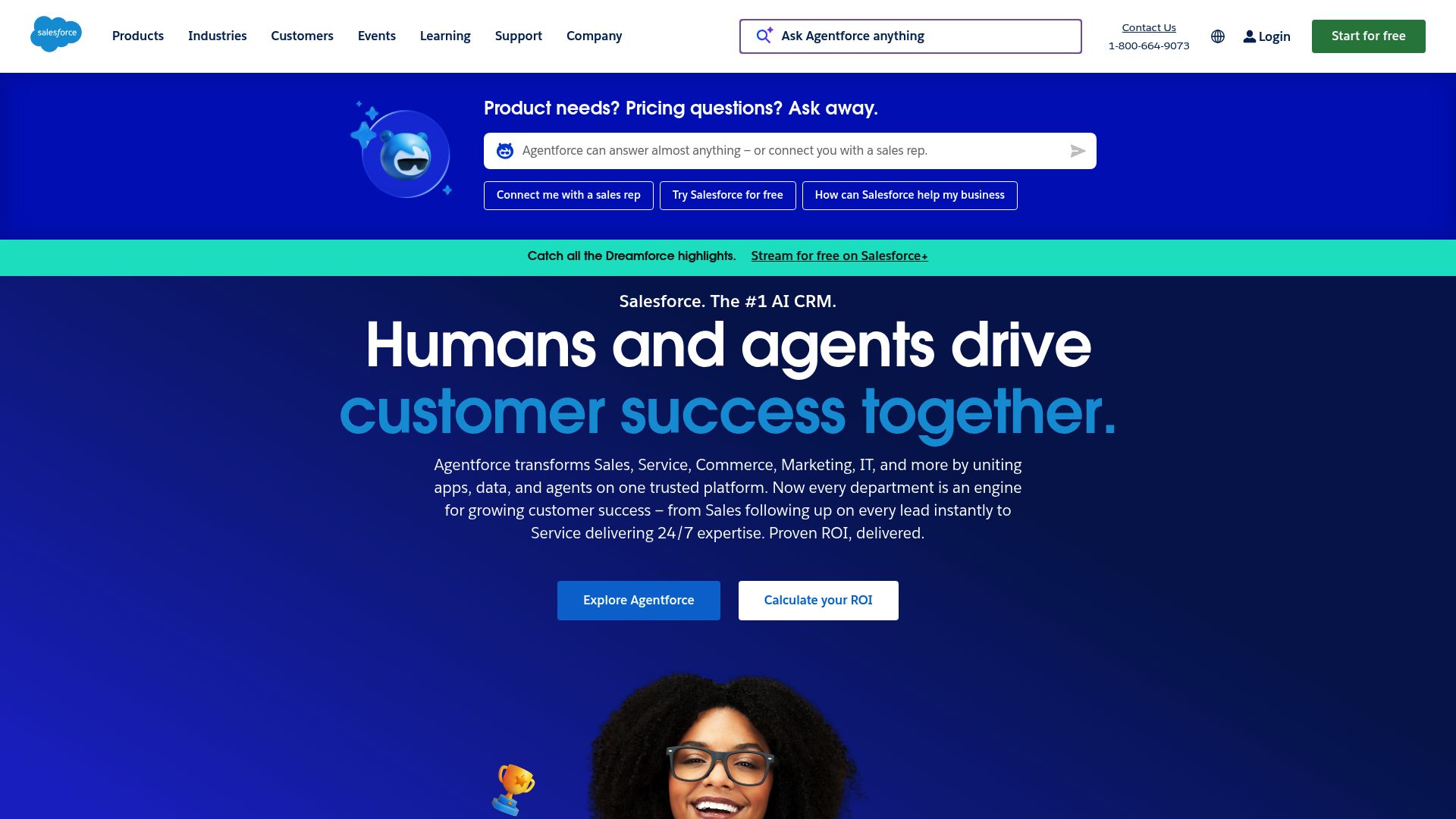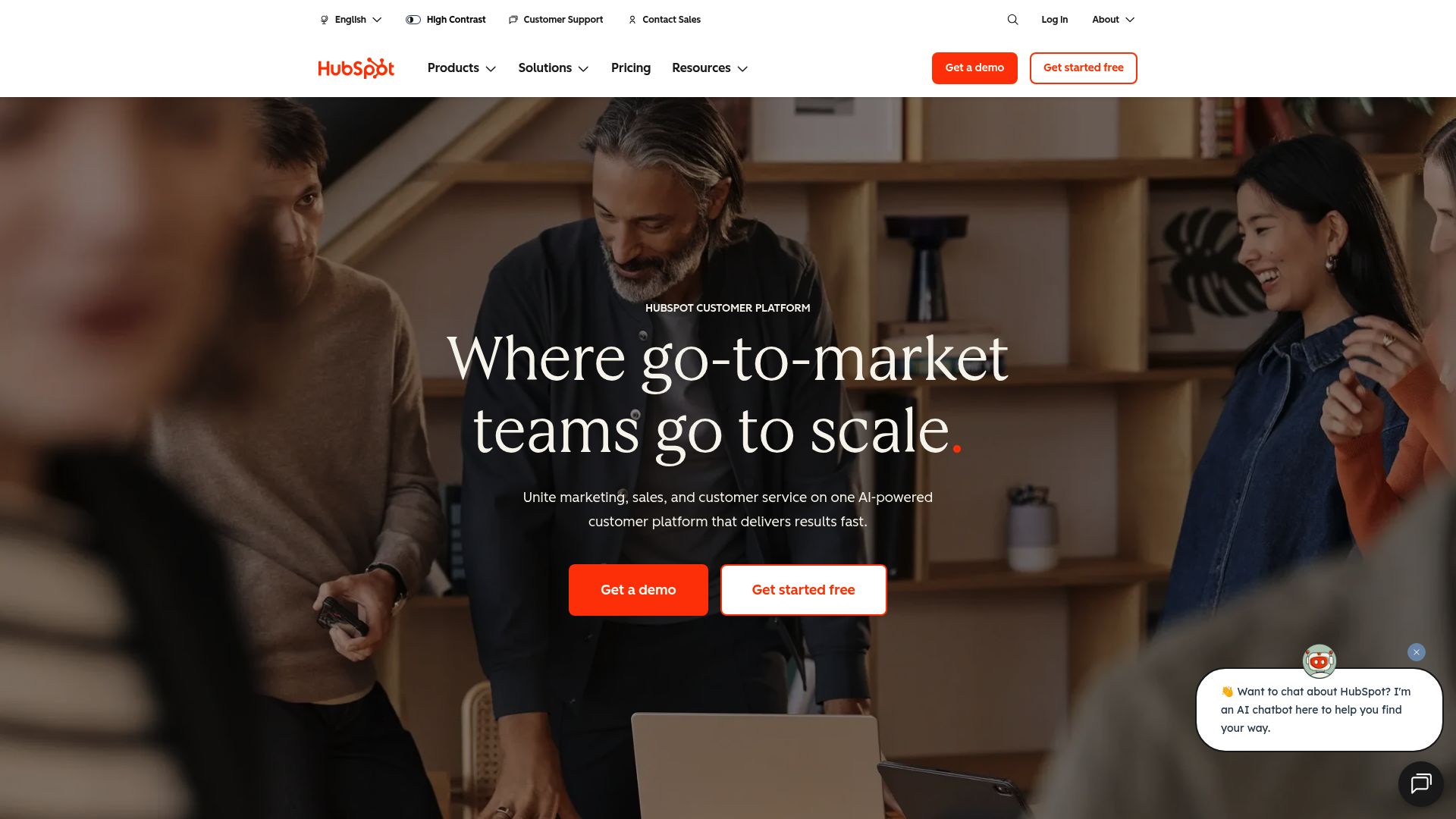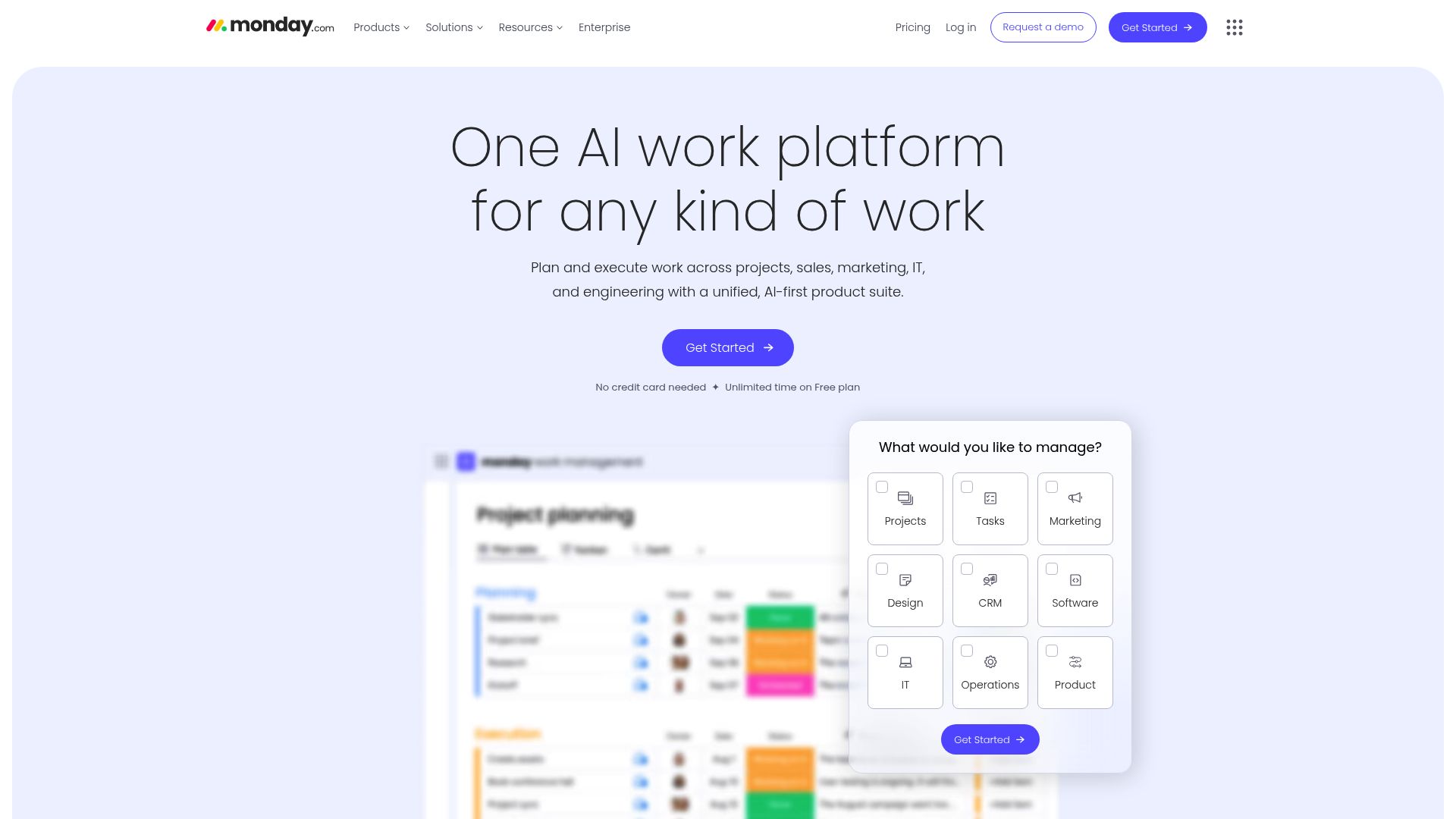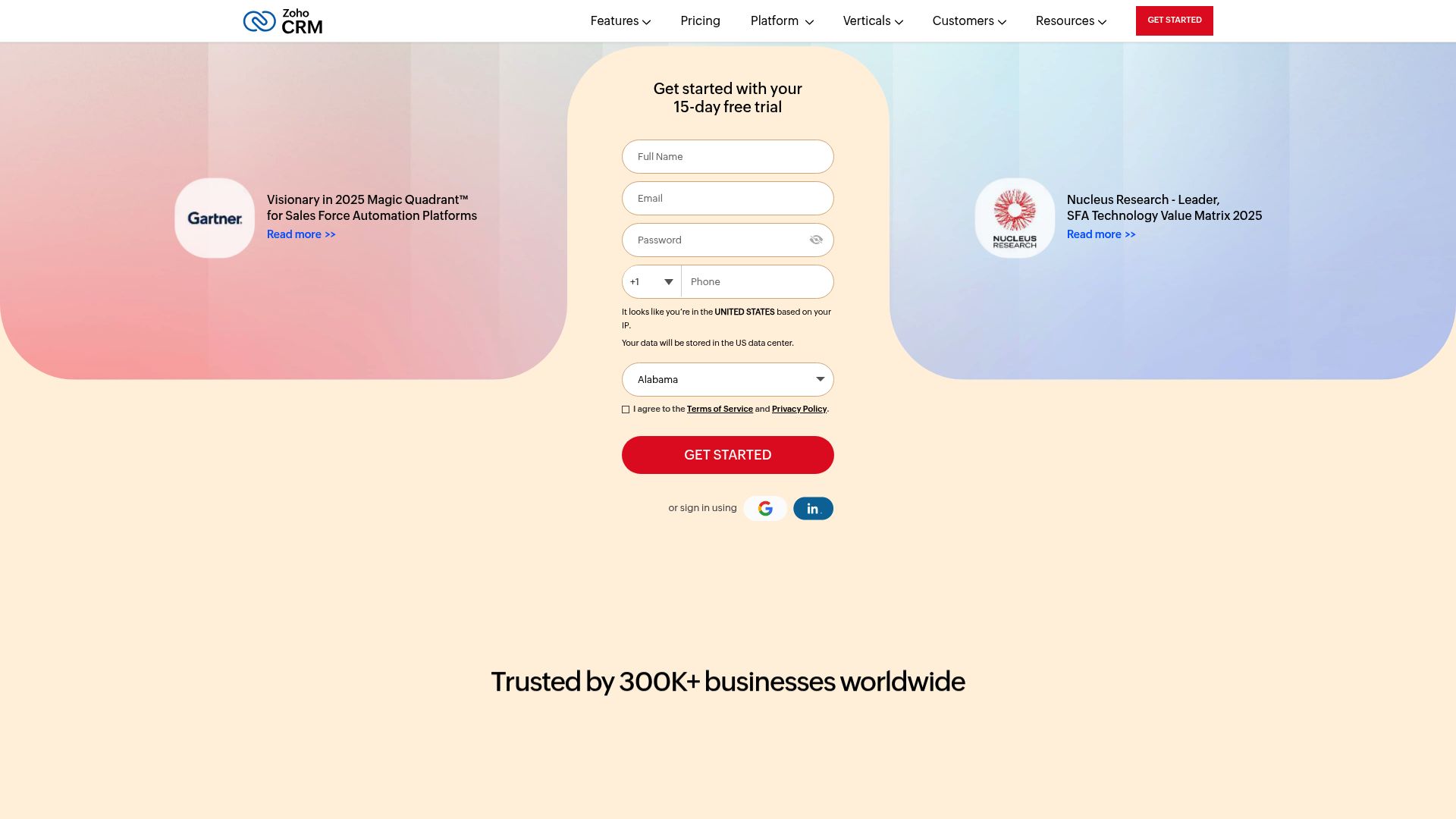Look, I’ve been testing Salesforce for months now, and I’m ready to share my unfiltered thoughts on whether this industry giant lives up to its reputation. From pricing concerns that made me nearly choke on my coffee to powerful features that actually surprised me, here’s what you need to know before making your decision.
Table of Contents
-
TL;DR: The Bottom Line on Salesforce
-
Salesforce CRM
-
Top Alternatives to Salesforce CRM
-
Frequently Asked Questions
-
Final Thoughts
TL;DR: The Bottom Line on Salesforce
-
There’s a reason everyone talks about Salesforce – its customization capabilities are genuinely unmatched
-
Expect to pay premium prices starting at $25/user/month, with enterprise plans reaching $500/user/month (yeah, it gets scary fast)
-
Implementation complexity can be overwhelming without technical expertise or dedicated resources – I’ve seen 4-month projects stretch to a year
-
The platform excels in scalability, integrations, and AI-powered features through Einstein (I was skeptical, but it actually works)
-
Smaller businesses might find better value with alternatives like HubSpot or Zoho CRM
-
Strong community support and learning resources make the steep learning curve manageable
Here’s the thing – Salesforce earned its reputation through genuine innovation and capability. But the price tag and complexity mean it’s not the right fit for everyone. I’ve seen businesses completely transform their operations with Salesforce, but I’ve also watched smaller companies struggle with implementation costs and learning curves that stretched for months. Don’t be like them.
Criteria Table
|
Criteria |
Rating |
Details |
|---|---|---|
|
Customization & Scalability |
5/5 |
Unmatched flexibility with custom objects, fields, and workflows. Scales from small teams to enterprise level. |
|
Feature Completeness |
4/5 |
Comprehensive CRM features but lacks some built-in tools like chatbots and social listening. |
|
Ease of Use & Implementation |
3/5 |
Steep learning curve and complex implementation process requiring technical expertise. |
|
Integration Capabilities |
5/5 |
5,000+ AppExchange integrations plus robust API capabilities for custom connections. |
|
Pricing & Value |
3/5 |
Premium pricing starting at $25/user/month, with enterprise plans up to $500/user/month. |
|
Support & Community |
5/5 |
Excellent Trailhead learning platform, active community, and comprehensive documentation. |
|
Security & Reliability |
5/5 |
Enterprise-grade security features, compliance certifications, and excellent uptime. |
Salesforce CRM

What Salesforce is Best Known For
Look, I’ll be straight with you – Salesforce didn’t become the CRM king by accident. I’ve been in the software game long enough to see companies rise and fall, but this one’s stuck around for good reason.
Here’s the thing that blew my mind when I first started using it: you can basically rebuild the entire platform to match exactly how your business works. I’m talking custom fields, workflows, objects – the whole nine yards. Last year, I worked with a manufacturing company that turned Salesforce into something that looked nothing like a traditional CRM. It was handling their inventory, customer orders, and even maintenance schedules. Wild stuff.
Now, about that Einstein AI everyone keeps talking about. I’ll admit, I was skeptical at first – seemed like marketing fluff. But honestly? It actually works. The thing analyzes your old deals and tells you which leads are worth your time. I watched a sales rep ignore a “low-priority” lead that Einstein flagged as high-value, and guess what? That lead closed for $50K three weeks later. The rep never made that mistake again.
The AppExchange marketplace is where things get really interesting. Over 5,000 integrations sounds impressive on paper, but here’s what it actually means: remember that weird industry-specific tool your company can’t live without? Yeah, there’s probably an app for that. I’ve seen integrations for everything from food truck management to funeral home operations. No joke.
Key Features That Matter
Sales Cloud handles your entire pipeline, and I mean everything. The opportunity management features are solid – you can track where deals are, forecast revenue, and keep tabs on what your team’s actually doing (instead of what they say they’re doing). What I really love is how it automates the boring stuff so your salespeople can focus on, you know, selling.
Service Cloud is where customer support gets interesting. I remember helping a client set this up, and their support tickets went from chaos to organized in about two weeks. Having every customer interaction in one place is a game-changer – no more “let me transfer you to someone who might know your history.”
Marketing Cloud brings all your campaigns together, which sounds simple but isn’t. Multi-channel marketing, email sequences, social media – it’s all connected. The scary part? It actually works. I’ve seen companies increase their lead conversion by 40% just by having their marketing and sales data talk to each other properly.
The reporting capabilities deserve their own paragraph because they’re genuinely impressive. Custom dashboards give you real-time visibility into everything. Revenue forecasting, team performance, customer satisfaction – it’s all there in formats that don’t make your eyes glaze over. Though I’ll warn you, you can spend hours just playing with different chart types.
Pros
Unmatched Customization Power
This is where Salesforce really shines, and I’m not just saying that. You can build exactly what your business needs, not what some software company thinks you need. Custom objects, fields, workflows – the platform adapts to your crazy processes instead of forcing you to change everything.
I worked with a law firm that needed to track billable hours, court dates, and client communications all in one place. Three weeks later, they had a system that looked nothing like a traditional CRM but worked perfectly for their needs. Try doing that with most other platforms.
Scales From Startup to Enterprise
Whether you’re a 5-person team or managing thousands of employees, Salesforce grows with you. I’ve seen companies go from 10 users to 500 without breaking a sweat. The platform handles increased data loads and complexity without choking – which is more than I can say for some alternatives I’ve tried.
Industry-Leading Integration Ecosystem
The AppExchange marketplace is genuinely impressive, and I don’t throw that word around lightly. Need to connect your accounting software? There’s probably three apps for that. Want to integrate with your marketing automation tool? Multiple options available.
Here’s a real example: I had a client using some obscure inventory management system from the ’90s. Found an AppExchange integration that connected it to Salesforce. Problem solved in an afternoon instead of months of custom development.
Robust AI and Analytics
Einstein AI provides insights that actually matter, not just fancy charts that look good in presentations. Lead scoring helps you focus on prospects who’ll actually buy, and the opportunity insights have saved me from chasing dead-end deals more times than I can count.
The AI learns from your specific business patterns too. It’s not using generic algorithms – it’s studying how your company closes deals and finding patterns you might miss.
Exceptional Support and Learning Resources
Trailhead is honestly one of the best learning platforms I’ve ever used, and it’s completely free. The Trailblazer community is active and helpful – I’ve gotten answers to weird technical questions at 11 PM on a Sunday. Plus, if you’re on higher-tier plans, their support team actually knows what they’re talking about.
Cons
Premium Pricing That Adds Up Fast
Okay, let’s talk about the elephant in the room. That $25/user/month starting price? It’s basically a teaser. Most businesses need the $100+ plans to get anything useful done. I’ve seen companies start with a $500/month budget and end up paying $2,000+ once they add the features they actually need.
Enterprise plans can hit $500/user/month, which makes Salesforce one of the most expensive CRM options out there. Do the math on a 50-person sales team. Yeah, it gets scary fast.
Complex Implementation Process
Getting Salesforce set up properly isn’t a weekend project. I’m talking weeks or months of configuration, and that’s if you know what you’re doing. Most businesses end up hiring consultants, which adds another $10K-50K to the bill.
Last month, I helped a client who thought they could handle implementation themselves. Four months later, they finally called for help. Don’t be like them – budget for professional setup from the start.
Steep Learning Curve
Salesforce’s power comes with complexity, and that complexity can be overwhelming. I’ve seen experienced sales reps – people who’ve used CRMs for years – struggle with Salesforce for their first few weeks.
The interface makes sense once you learn it, but that learning process takes time. Plan on training being essential, not optional. And I mean real training, not just watching a 10-minute YouTube video.
Limited Out-of-the-Box Lead Capture
Here’s something that bugs me: for all its power, Salesforce doesn’t include basic stuff like chatbots or social listening tools in the base plans. You’ll need third-party integrations or expensive add-ons to get features that come standard with competitors like HubSpot.
Want a simple contact form on your website that feeds into Salesforce? That’ll be extra, thank you very much.
Criteria Evaluation
Customization & Scalability: 5/5
This is where Salesforce absolutely dominates. I’ve never found a platform that lets you customize as much without breaking. You can create custom objects, fields, and workflows that perfectly match your business processes – no matter how weird they are.
The scalability is equally impressive. I’ve worked with companies managing everything from 100 contacts to 10 million, and Salesforce handles it all. The platform grows with your business without requiring major overhauls.
Feature Completeness: 4/5
Salesforce covers all the CRM basics exceptionally well. Sales Cloud and Service Cloud are mature, comprehensive platforms that handle most business needs.
But here’s what annoys me: basic features like chatbots, social media listening, and advanced lead capture tools aren’t included in standard plans. You’ll need add-ons or integrations to fill these gaps, which feels like nickel-and-diming.
Ease of Use & Implementation: 3/5
This is where Salesforce shows its complexity. The interface is actually pretty intuitive once you learn it, but that learning process can be brutal. I’ve seen new users feel completely overwhelmed by the sheer number of features and configuration options.
Implementation often requires technical expertise or consulting help. It’s not a plug-and-play solution, and anyone telling you otherwise is probably trying to sell you something.
Integration Capabilities: 5/5
The AppExchange marketplace is genuinely impressive – over 5,000 third-party integrations. Whether you need accounting software, marketing tools, or industry-specific applications, there’s likely an integration available.
The API capabilities are robust too. When pre-built options don’t exist, custom integrations are totally doable. This connectivity eliminates the data silos that plague businesses using multiple software tools.
Pricing & Value: 3/5
Let’s be honest – Salesforce is expensive. Starting at $25/user/month puts it above most competitors, and you’ll likely need higher tiers for meaningful functionality. Enterprise plans can reach $500/user/month, which is just ridiculous for most businesses.
The value depends on your situation. Large organizations with complex needs often find it worthwhile. Small businesses? You’re probably better off with something more affordable.
Support & Community: 5/5
Trailhead is comprehensive and free – I can’t stress this enough. The Trailblazer community actively helps solve problems and shares best practices. Official support (on higher tiers) is responsive and actually knowledgeable.
The documentation is thorough, and there are countless tutorials and resources available. This support ecosystem makes the platform’s complexity much more manageable.
Security & Reliability: 5/5
Security is where Salesforce really delivers. Single sign-on, multi-factor authentication, IP restrictions – it’s all standard. Data encryption and compliance certifications meet enterprise requirements without breaking a sweat.
System reliability is excellent too. Downtime is rare, and when it happens, they communicate transparently about what’s going on. The cloud infrastructure scales automatically to handle demand spikes.
Community Reviews and Expert Recommendations
Real users consistently praise Salesforce’s ability to scale with business growth. One review that stuck with me: “Being in the cloud with Salesforce gave us full confidence that we could scale.” This sentiment shows up repeatedly across G2 and Capterra.
The unified customer view gets frequent mentions too. Users love having all customer communications and files in one place. As one reviewer put it: “The one thing that Salesforce does that I wasn’t expecting was to keep all of how I communicate and all of my files in one place.”
Marketing teams specifically value the analytics capabilities. “With Salesforce, we can see what promotions worked best, and why” – this kind of insight helps businesses make data-driven decisions instead of just guessing.
But the reviews aren’t all sunshine and rainbows. Common complaints focus on implementation complexity and cost. Many TrustRadius users mention needing external consultants to get Salesforce properly configured. The learning curve is frequently cited as steeper than expected – and honestly, they’re not wrong.
Pricing
Salesforce’s pricing reflects its position as a premium solution, and boy does it show. The Starter Suite at $25/user/month gets you basic functionality, but most businesses quickly realize they need more features. It’s like buying a car with no air conditioning – technically functional, but you’ll want the upgrade.
The Pro Suite ($100/user/month) includes advanced customization and automation features that make Salesforce actually powerful. This is where most small to medium businesses end up if they choose Salesforce, though the sticker shock is real.
Enterprise ($165/user/month) and Unlimited ($330/user/month) plans add advanced analytics, increased storage, and premium support. Large organizations typically need these tiers for full functionality, which explains why enterprise software budgets are so massive.
The Einstein 1 Sales plan at $500/user/month includes advanced AI features and unlimited customization. This tier is for organizations that want every possible feature Salesforce offers and have the budget to match.
There is a free plan available, but calling it “limited” is generous. It works for basic contact management but lacks the features that make Salesforce compelling. It’s more of a trial than a real solution.
Where to Find Salesforce
You can start your Salesforce journey directly through their website. They offer a 30-day free trial that lets you explore the platform before committing to a paid plan. Fair warning though – 30 days isn’t really enough to fully evaluate something this complex.
Top Alternatives to Salesforce CRM
HubSpot CRM – The User-Friendly Powerhouse

HubSpot deserves serious consideration if you want enterprise features without the enterprise headaches. Starting at $15/user/month (compared to Salesforce’s $25), it delivers solid value for growing businesses that don’t want to hire a consultant just to get started.
Here’s what blew me away: the free plan is actually useful – not just some marketing gimmick. You get contact management, deal tracking, and basic reporting without paying anything. I’ve seen small businesses run successfully on HubSpot’s free plan for months while they figured out their needs.
Implementation is significantly easier than Salesforce. Most businesses can get up and running in days rather than weeks. The interface feels intuitive from day one, which means less training time and fewer frustrated employees.
Marketing automation is where HubSpot really shines. Email sequences, landing pages, and lead nurturing tools are built-in and work seamlessly together. If inbound marketing is part of your strategy, HubSpot’s integrated approach is genuinely hard to beat.
Try HubSpot CRM free to see if it meets your needs.
Monday CRM – Visual Project Management Meets CRM

Monday CRM takes a completely different approach by blending project management with customer relationship management. At $12/user/month, it’s one of the most affordable options available, especially compared to Salesforce’s premium pricing.
The visual dashboards are Monday’s standout feature, and honestly, they’re pretty brilliant. Color-coded boards make it easy to see deal stages, project status, and team workloads at a glance. If your team thinks visually ( like mine does), Monday’s interface will feel natural immediately.
Customization is surprisingly extensive despite the lower price point. You can create custom fields, workflows, and automations that rival much more expensive platforms. The drag-and-drop interface makes configuration accessible to non-technical users – no coding required.
However, Monday CRM works best for businesses that need both project management and CRM functionality. If you only need customer relationship management, dedicated CRM platforms might serve you better.
Explore Monday CRM to see their visual approach in action.
Zoho CRM – Small Business Friendly

Zoho CRM strikes a nice balance between functionality and simplicity. At $14/user/month, it provides essential CRM capabilities without the financial burden that comes with enterprise-focused solutions like Salesforce.
The company behind Zoho has built a solid reputation for creating user-friendly business tools, and their CRM continues this tradition. Setup is straightforward, and most teams can become productive within their first week – a stark contrast to Salesforce’s months-long implementation process.
Customization options are solid without being overwhelming. You can create custom fields, workflows, and reports that match your business needs. The automation features help streamline repetitive tasks, though they’re not as advanced as what you’ll find in Salesforce.
Integration capabilities are respectable too. While Zoho doesn’t have the massive marketplace that Salesforce offers, it connects with most popular business tools. The native integrations with other Zoho products create a cohesive business suite if you’re already using their other applications.
Frequently Asked Questions
Is Salesforce worth the high cost for small businesses?
Honestly? Probably not for most small businesses. I’ve seen too many small teams struggle with the pricing – it starts at $25/user/month, but you’ll likely need higher tiers to get meaningful functionality. Small teams often find better value with HubSpot’s free plan or Zoho’s more affordable options.
How long does Salesforce implementation typically take?
Implementation varies wildly based on complexity, but expect 2-6 months for most businesses. Simple setups might take a few weeks if you know what you’re doing, while complex customizations can stretch to a year or more. Don’t forget to factor in training time for your team – that’s often longer than the actual setup.
Can I migrate data from my current CRM to Salesforce?
Yes, Salesforce provides data migration tools and services. However, the process can be complex depending on your current system. Here’s my advice: clean up your existing data before migration to avoid importing garbage into your shiny new system. I learned this the hard way when we migrated 10,000 duplicate contacts and spent weeks cleaning them up afterward.
What’s the difference between Salesforce and HubSpot?
Salesforce offers way more customization and scalability but requires more technical expertise and patience. HubSpot is easier to use and implement, with really strong marketing automation features built right in. HubSpot also has a genuinely useful free plan, while Salesforce’s free option is pretty much useless for real business needs.
Do I need technical expertise to use Salesforce effectively?
For basic use? Not really. But to unlock Salesforce’s real power through customization and automation, technical knowledge helps a ton. Many businesses hire Salesforce consultants or dedicate internal resources to platform management. I’ve seen companies spend $30K on consultants just to get their workflows set up properly.
How does Salesforce’s AI (Einstein) actually help in practice?
Einstein analyzes your historical data to score leads, predict deal outcomes, and suggest next best actions. It’s particularly useful for prioritizing which prospects deserve immediate attention and forecasting revenue with greater accuracy than manual methods. I was skeptical at first, but watching it correctly predict which deals would close converted me into a believer.
What happens if I outgrow my current Salesforce plan?
Upgrading is straightforward – you can move to higher tiers without losing data or configurations. The platform scales seamlessly, though your costs will jump substantially with each tier. I’ve seen companies go from $1,000/month to $5,000/month practically overnight when they needed more features.
Are there hidden costs beyond the monthly subscription?
Oh boy, are there ever. Additional expenses often include implementation consulting ($10K-50K), training, third-party integrations, and extra storage. Many businesses underestimate these costs when budgeting for Salesforce adoption. I always tell clients to double their initial budget estimate – they usually end up closer to that number.
Final Thoughts
After spending way too much time evaluating Salesforce against its competitors, here’s my honest take: this platform absolutely deserves its market-leading position. The customization capabilities, scalability, and integration ecosystem are genuinely impressive – I’m not just saying that to fill space.
But here’s the thing – Salesforce isn’t the right choice for everyone, and the sales reps won’t tell you that. The high costs and implementation complexity make it complete overkill for many small businesses. If you’re running a team of 10 people with straightforward sales processes, you’ll probably get way better value from HubSpot or Zoho. Trust me on this one.
Where Salesforce makes sense:
-
Large organizations with complex sales processes that need serious customization
-
Businesses with dedicated IT resources or budget for consultants (this is crucial)
-
Companies that need advanced AI and analytics capabilities
-
Teams that can handle a steep learning curve in exchange for powerful features
Where alternatives might serve you better:
-
Small businesses with limited budgets (most small businesses, let’s be honest)
-
Teams wanting quick implementation without months of setup
-
Organizations prioritizing ease of use over endless customization options
-
Companies needing basic CRM functionality without all the bells and whistles
Salesforce has built something remarkable, but remarkable doesn’t always mean right for your specific situation. I’ve seen too many businesses choose Salesforce because it’s the “industry standard” only to struggle with implementation for months.
My advice? Take advantage of free trials, talk to current users in your industry (not just the success stories on their website), and honestly assess your team’s technical capabilities before making this significant investment. Don’t let a smooth-talking sales rep convince you that implementation is “easy” – it’s not.
Remember, the best CRM is the one your team will actually use consistently. Sometimes that means choosing the simpler, less feature-rich option that gets adopted quickly over the powerful platform that sits unused because it’s too complex for your current needs. I’ve seen it happen more times than I care to count.



